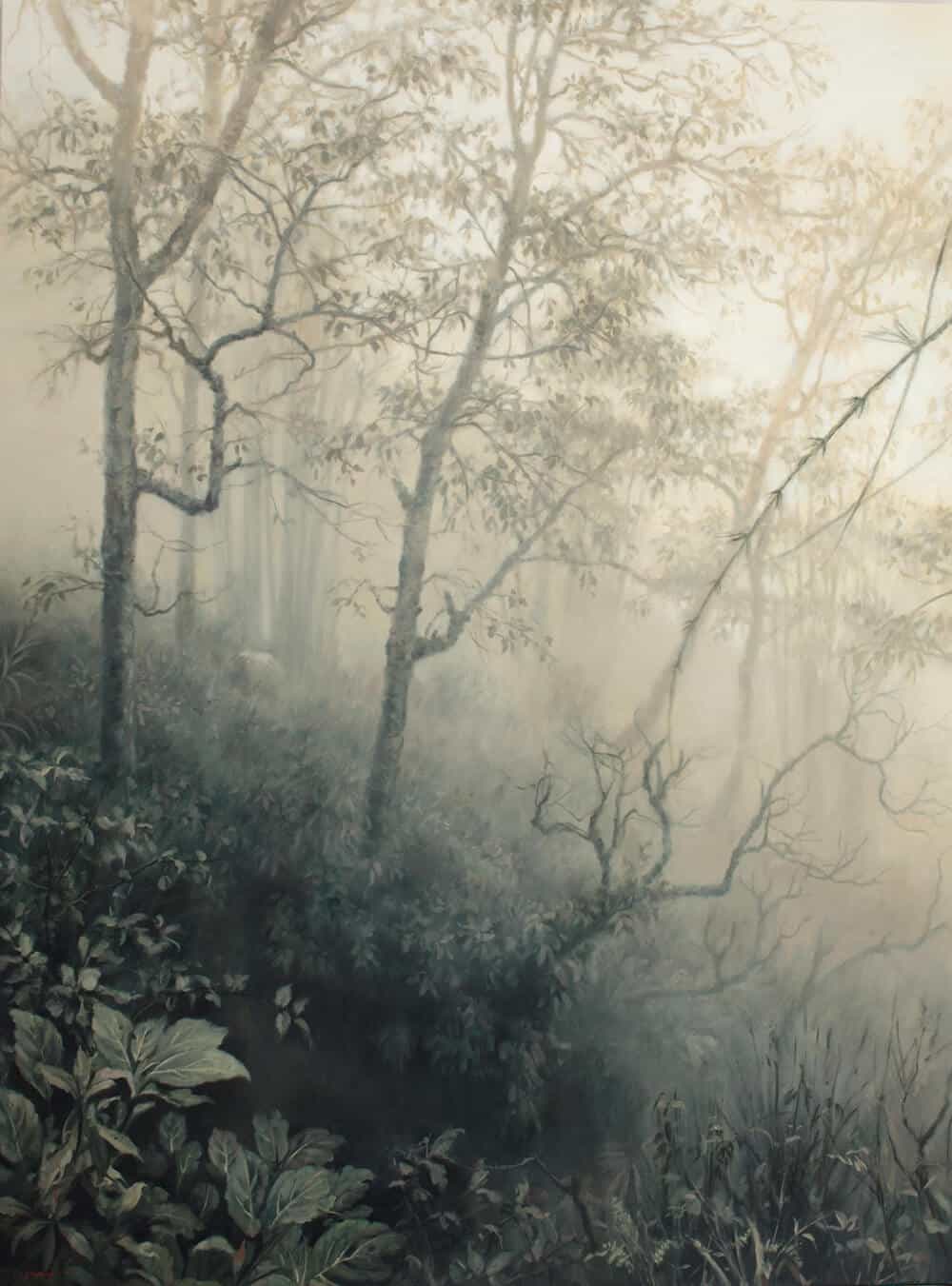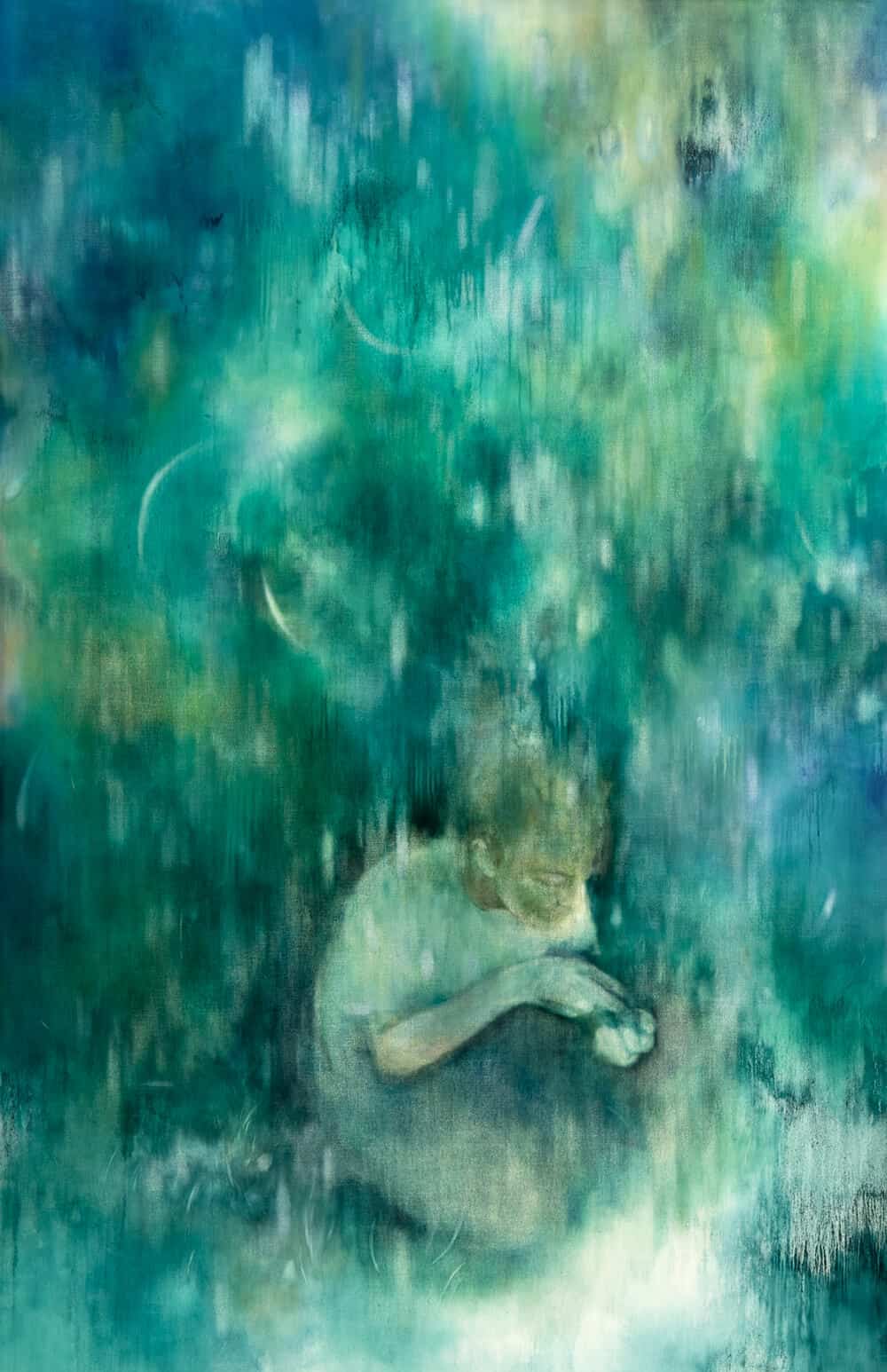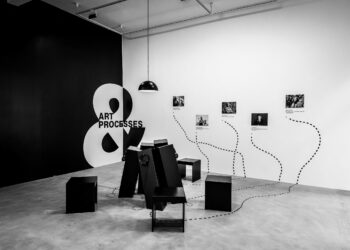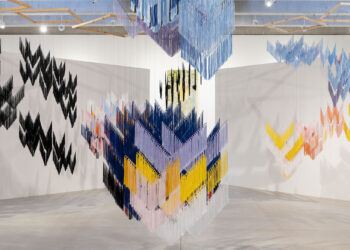According to Walter Benjamin – cultural critic, essayist and German Jewish philosopher – “for the Romantics, and for speculative philosophy, to be critical meant to elevate thinking so far beyond all restrictive conditions that the knowledges of truth sprang forth magically, as it were, from insight into the falsehood of these restrictions”.
 Jaco van Schalkwyk, Faraway Exotic, 2017. Oil on Belgian linen, 175 × 130 cm. Courtesy of the artist & Barnard.
Jaco van Schalkwyk, Faraway Exotic, 2017. Oil on Belgian linen, 175 × 130 cm. Courtesy of the artist & Barnard.
Developed as a reaction to the Industrial Revolution, the Age of Enlightenment and the scientific rationalisation of nature, Romanticism set out to elevate critical thinking far beyond the very rational limits of Enlightenment thinking, and turned to nature and emotion as an authentic source of aesthetic experience.
It was a glorification of the natural world, a celebration of the past – a time prior to the transformation of rural areas in Europe and Britain into industrial and urban zones – and a free expression of sublimity and the feelings of the artist. And it is exactly this – the harnessing of emotion – that allowed for the knowledges of truth to spring forth magically, free from any boundaries. For Charles Baudelaire, “Romanticism [was] precisely situated neither in choice of subject nor exact truth, but in the way of feeling”.
More than a century on, and contemporary painters from South Africa have revived an interest in representing subject-matter that escapes reason or logic. Curated by Mary Corrigall and presented at Barnard in Cape Town, the ‘New Romantics’ considers local artists whose work is preoccupied with the area where nature, science and the sublime converge under the banner of Romanticism.
In her curatorial statement, Corrigall writes that “painters of [the Romantic] era were similarly standing at the threshold of radical shifts as industrialisation and enlightenment were shaping the world. Conversely, a contemporary generation of artists, evincing this ‘Romantic’ style, are capturing and embracing uncertainty wrought by threats to the environment, and the rise of virtual reality in the post-industrial and information era.”
As the globe finds itself in the midst of socio-economic, political and environmental transformations, these artists have turned to nature as a form of refuge – an apolitical space in which to intuitively follow their painterly impulses.
 Sarah Biggs, The task at hand, 2017. Oil on canvas, 190 × 123 cm. Courtesy of the artist & Barnard.
Sarah Biggs, The task at hand, 2017. Oil on canvas, 190 × 123 cm. Courtesy of the artist & Barnard.
For Alexia Vogel, this escape – conscious or not – can be found in her vast, immersive canvases and vivid works on paper. Her imagined paradise in River Run II disavows the logic of time to reach a space and state more felt than perceived, and with her mark-making directed by instinct and spontaneity, Vogel translates the canvas into an amoebic, sublime expression of the nature of nostalgia, fantasy and wanderlust.
The same can be said of Sarah Biggs. Her expressive treatment of natural settings hover at the threshold between figuration and abstraction, and leads towards an evasive psychic territory. Here, Biggs turns to nature as an authentic source of aesthetic experience, and represents sublimity in overshadowing figures who have been enveloped by abstract and organic forms. Her works form a complex dance between chaos and the relentless belief in meaning and logic, where the very paint expresses this tension – allowing the surfaces to constantly move, always forming and becoming as pigments seep and meet each other.
While the Romantics were notorious for emphasising emotions such as apprehension, horror, terror and awe – and these notions can most certainly be felt in the work of some artists up on exhibition in the ‘New Romantics’ – remaining true to their elevation of human emotion, they also expressed a greater understanding of what it meant to feel joy.
In 1818, at the height of Romanticism in Europe and Great Britain, English Romantic painter John Constable wrote in a letter to his friend that “for a man who is sensitive to nature, happiness consists in expressing nature. How infinitely happy, then, is the man who reflects nature like a mirror without being aware of it, who does the thing for love of it and not from any pretensions to take first place”.
Combined with the seemingly infinite space within Barnard’s ephemeral white walls, Rosie Mudge’s The Vision – glitter glue and automotive paint on canvas – exudes an almost divine joy as the sun catches the glitter continuously, at once always becoming and elevating thinking so far beyond all restrictive conditions, that the knowledges of truth spring forth magically, from an insight into the very falsehood of these restrictions. The very absence of subject matter allows the work to incorporate the viewer into an intimate experience, and uses emotion as a source of aesthetic experience.
 Robyn Penn, After the failure of Ideals I, 2018. Oil on canvas. Courtesy of the artist & Barnard.
Robyn Penn, After the failure of Ideals I, 2018. Oil on canvas. Courtesy of the artist & Barnard.
Read together, the artworks included in the ‘New Romantics’ take a broad look at the notion of Romanticism in contemporary South African painting, and explores how emotion and nature may become a place of refuge for so many artists who find themselves situated neither in choice of subject nor exact truth, but rather in the way of feeling. The exhibition at once presents a nervous preoccupation with perpetually changing inner states of consciousness, and a longing for the unbounded and the indefinable – a passionate effort of painting for painting’s sake, and doing the thing for the love of it, without any pretensions to take first place.
Artists included in the ‘New Romantics’ are: Alexia Vogel, Ronél de Jager, Sarah Biggs, Jaco van Schalkwyk, Katherine Spindler, Heidi Fourie, Marcus Neustetter, Robyn Penn and Rosie Mudge.
The exhibition will be up on show at Barnard until the 6th March, 2018.
Ellen Agnew is a writer on ART AFRICA‘s editorial team.



